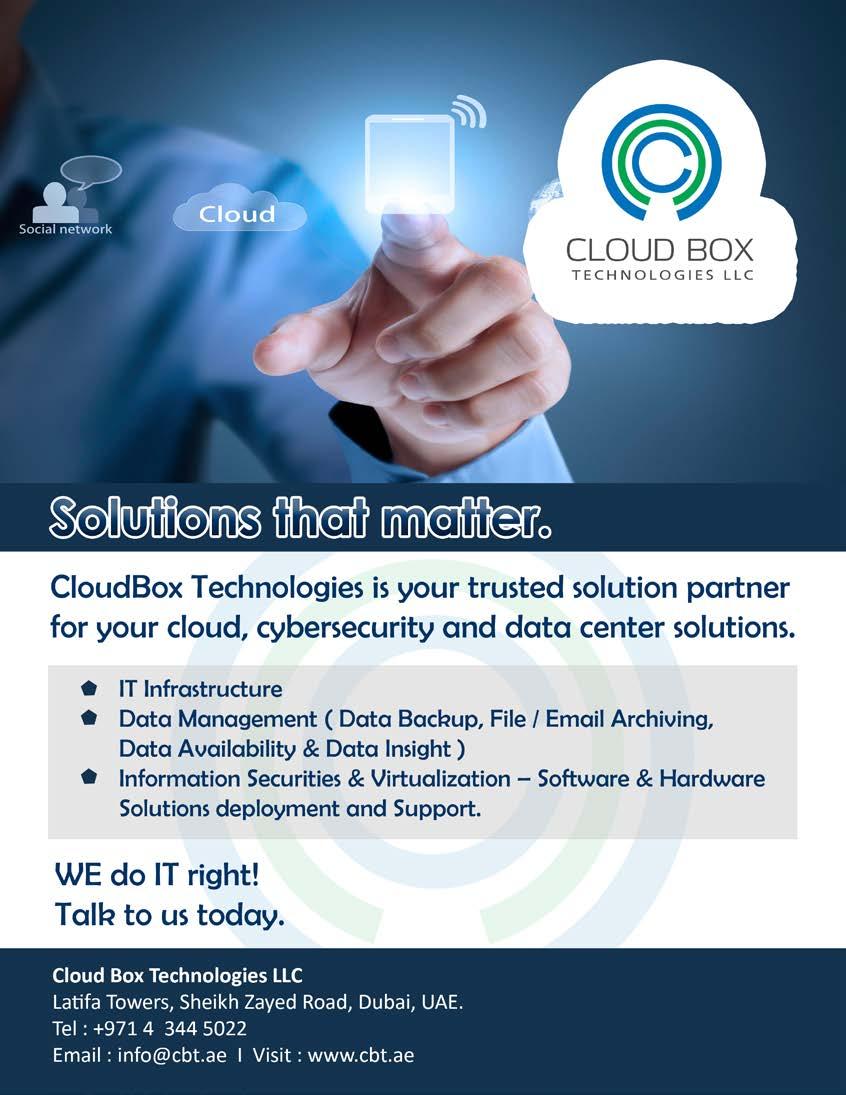
7 minute read
AppDynamics
APPDYNAMICS THE NEED FOR NETWORK VISIBILITY
David Noël, Regional Vice President, Southern Europe, Middle East & Africa at AppDynamics has penned an exclusive op-ed for November’s edition of CNME, in which he explains the importance of end-to-end network visibility in order to deliver a modern digital experience.
David Noël
Regional Vice President, Southern Europe, Middle East & Africa at AppDynamics For consumers across the Middle East — an increasing number of which are digital natives — modern technology has transformed the way we live, work and play. And the challenges of home working, home schooling and social distancing in the last few months have likely made us even more reliant on the digital services that are a deeply fundamental part of everyday life. The takeaway for businesses is clear — consumers expect brandengagement options to be wideranging and have no patience for issues such as confusing interfaces and high latency.
Against this backdrop, application performance management (APM) has never been more important. The modern enterprise’s digital platform is now indistinguishable from its brand. But even as regional players get to grips with this axiom, they face yet more complexity… in their networks. Hybrid environments that include personal endpoints, and home and public networks are all coming into play. And an
already-beleaguered IT function has to contend with the following conundrum — how do we keep tight control on the digital experience from the employee to the customer, across all the networks within our purview, to deliver top-drawer performance from our platform?
Legacy tools aren’t enough
As IT teams are asked to do more and more, we have come to realise that legacy monitoring tools such as SNMP and pcap are incapable of delivering the required visibility outside the corporate perimeter. In the COVID-accelerated digital age, we need to venture into the previously unknown and monitor networks and devices outside of our control. Only then can we optimise mean time to resolution (MTTR) on performance issues. Remember, for a B2C business, these issues mean disgusted end users switching to competitors. For B2B enterprises, they can mean violation of service-level agreements (SLAs) or service-level objectives (SLOs). None of this bodes well for profitability, for any scale of business, in any industry.
Traditional monitoring tools belong to what is now a bygone era — one of total control by IT. The cloud, Internet and -aaS platforms are now integral parts of the technology stack — a poisoned chalice thrust upon admins, who in many cases have neither the tools nor experience to handle them. Legacy IT was never meant to handle the sudden appearance of countless personal devices that daily hop from network to network.
To deliver consistent, optimal performance, complete visibility is necessary. Keeping the new digital customer coming back for more requires that you have a comprehensive view into customer experience (CX) that includes delivery, performance, and KPIs, no matter where your users are. For example, if you have a public-network issue, you must be able to tie it to its source quickly. Was it an ISP? Was it a failure in a cloud service? Working in real time is crucial because your customers also become dissatisfied in real time. Next-day resolution is no good for the digital enterprise.
Action stations!
So, what steps can you take to address end-to-end visibility? Your corporate perimeter has been pushed outward and that means you need to see more than before to keep ahead of issues. Internet and hybrid-cloud visibility starts with ensuring that you have insight into every dependency in your delivery platforms, from distributed resources to thirdparty API services.
So challenging is the process of tracking down issues, that a new metric — mean-timeto-identification (MTTI) — has emerged. But accurate calculation of MTTI still calls for that all-important crossnetwork visibility. Broad and deep in its scope, this visibility should probe the finest levels of user experience to pinpoint issues quickly and tie them to ISPs or cloud-service failures.
We should also bear in mind that an increasing number of organisations are using SaaS
to deliver critical elements of their digital experience, presenting an effective black box to monitoring tools. SaaS experience monitoring can pull the covers back and perform granular analysis on these services. Without this level of visibility, there can be no accountability, and delivering consistent customer experiences can be problematic.
IT teams need to adopt a new way of looking at their domain. By understanding that the current lack of control can be overcome, they pave the way to reclaiming ownership of their technology stack. Regional companies that want to innovate will need to address these underlying nuances first. Somehow, there needs to be a seamless handoff between network and application operations teams for faster MTTR, all while correlating business metrics, application performance metrics, and outside-in network-related metrics to form a view that lineof-business users care about.
The benefits of end-to-end performance monitoring for your extended digital estate may be obvious. Delivery of a solution that covers all requirements and fits into your business model will require a hunt for the ideal partner. As with all business-strengthening moves, strategic partnerships will be key. But get it right and you become the puppet-master, no longer chasing cul-de-sacs, but in control of every cell of every nerve-ending within your digital domain.
RIVERBED NETWORKS OF THE FUTURE
Mena Migally, Regional Vice President, META at Riverbed, has compiled an exclusive op-ed for November’s edition of CNME, which examines how networks have been forced to adapt due to the increased demands that have been placed on them as a direct result of the COVID-19 pandemic.
As businesses begin to settle into a new and unpredictable normal, they are being forced into adapting their plans to maintain performance, drive productivity and support their workforce. But in adapting working practices, companies need to ensure that they are taking the right steps to build network resilience at the same time.
If they don’t, businesses risk opening the door to slow running and ineffective systems, hindering employee productivity and ultimately the company’s ability to successfully maintain business operations.
Work from anywhere setups are here to stay:
It is unquestionable that the pandemic has overhauled business attitudes to remote working. Organisations are now recognising that there is no longer a need for the majority of staff to work in the office, if it is not where they are most productive. In fact, recent research from Riverbed found that businesses are expecting a 50 percent increase in employees working remotely post COVID-19.
This requires a step up in network performance. In the face of a challenging economic climate, businesses need networks that can deliver productivity that is equal, if not better, than the traditional office
Mena Migally
Regional Vice President, META at Riverbed

set up. Meeting this challenge will require networks to evolve.
Networks are adapting to meet increased demand:
As a result of the rapid implementation of work from home policies, networks, limited by bandwidth and latency, struggled to maintain good speeds and levels of responsiveness. These network performance problems, in turn, negatively impacted employee productivity, as revealed in Riverbed’s recent research.
To tackle the latency challenge, and unlock efficiency, businesses need to embrace emerging technology and use it as a cornerstone for evolving their networks to become more resilient. For example, introducing 5G.
Thanks to its high bandwidth connections, 5G has the potential to drive productivity by providing staff with more reliable connections, giving them smoother and quicker access to applications and downloads, and enabling them to utilise internet of things devices.
However, adding 5G, and embracing the technologies it facilitates, could inadvertently damage employee productivity through increasing the complexity of the network if not combined with effective network management.
Adopting a multi-layered approach to network management:
To guarantee employees have reliable network and application access, and can utilise capabilities such as 5G, from anywhere, businesses must invest in technology that provides end-to-end visibility. This means adopting network performance management (NPM) solutions that collect and analyse the data flowing through every application on every device.
With this holistic overview, IT teams can easily identify anomalies such as slow running applications or employees who are unable to participate in video conferencing due to limited bandwidth. Armed with this information, they will be able to quickly understand the problem and take steps to resolve it.




